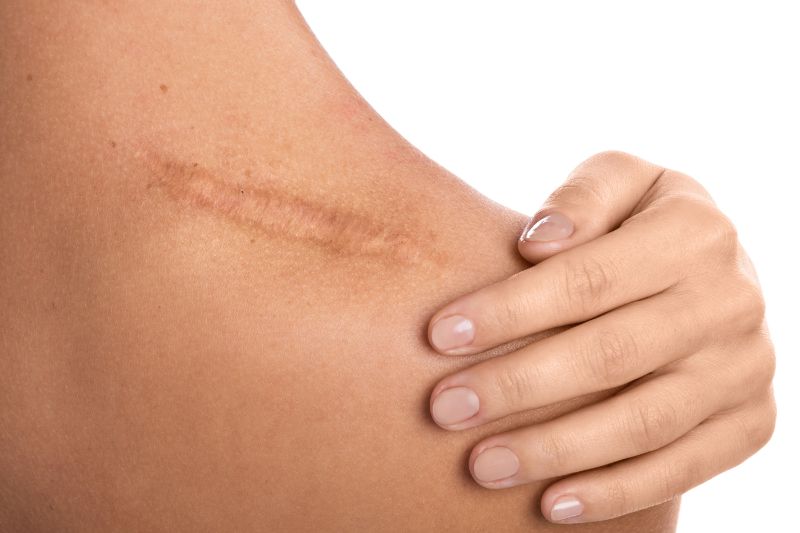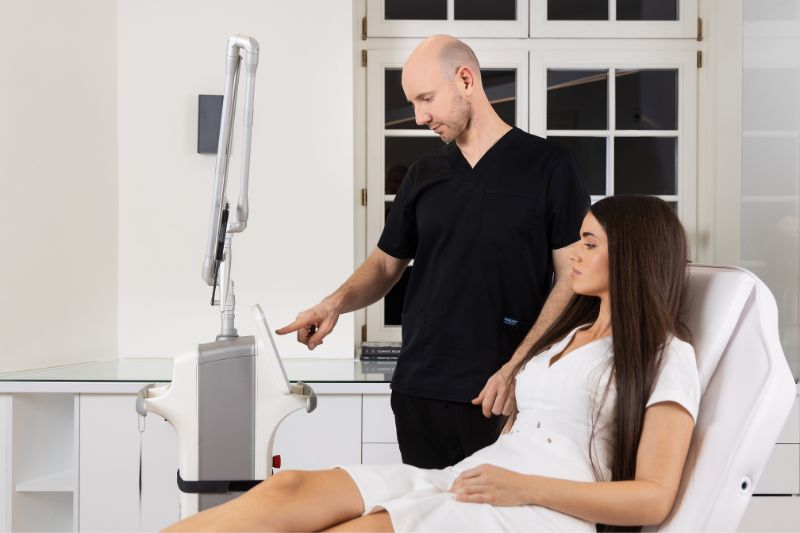Keloids and hypertrophic scars require effective treatment to permanently remove them from the skin. We successfully solve this aesthetic problem using modern lasers such as Candela CO2 and Dye VL.

What are keloids and hypertrophic scars?
Whether they are on the face or the body, scars represent a major aesthetic problem and impair the patient’s self-confidence. Scars occur as a result of injury, trauma, after surgery, inflammation, infection or other damage to the skin. During the healing process, the connective tissue in that place loses its function. The new connective tissue that replaces the damage cannot fully compensate for the loss, and this is where a scar forms. Depending on how the skin heals, the scar can be flush with the skin or above its surface, linear or wide.
At the place where the skin has atrophied, atrophic scars appear, which are most often the result of inadequate treatment of acne and pimples. They look like small depressions in the skin and we can distinguish several types of atrophic scars: icepick (they are narrow and deep in the skin), boxscar (they have sharp edges), rolling (small circular scars). Atrophic scars also include stretch marks.
Unlike atrophic scars that are below the surface of the skin, the other two categories of scars form above the surface of the skin. These are keloids and hypertrophic scars.
Keloid scars
Keloids or keloid scars are characterized by the following: their color is pinkish to red, they are smooth and hard to the touch, they are raised above the level of the skin, they are irregularly shaped and larger than the wound itself. They can be sensitive, often accompanied by itching and pain.
Keloid scars are caused by abnormal proliferation of scar tissue. During wound healing, there is an overproduction of collagen fibers that attempt to heal the wound. As a result, it happens that these fibers grow over the edge of the wound and thus visible traces in the form of keloid are created. They are most often formed after some trauma such as a burn, after bacterial infections of the skin, as a result of acne or in a postoperative scar. They form even over months, at first they are red-brown, and later pink to red in color. They mostly appear on the face (most often on the chin and lower part of the jaw), in the area of the earlobe, on the neck, chest and upper back. If they appear spontaneously, it is assumed that they are the result of a certain microtrauma that the patient did not even notice.
Hypertrophic scars
And this category of scars appears above the skin level, they look like bumps. They are made of tissue that has thickened over time and is different from the surrounding, healthy tissue. The collagen in this type of tissue is not arranged in bundles, as is the case with healthy skin, but is irregularly distributed. Hypertrophic scars are most often the result of an injury or occur at the site of an incision, after surgery. The edges of such scars are straight, and their color is red to purple. They are hard to the touch and can be painful, and the skin in these places is dry and dehydrated.
Laser treatment for keloids and hypertrophic scars
First of all, it is important to note that the treatment of keloid and hypertrophic scars always represents a great challenge and requires patience from the patient. Both types of scars are above the surface of the skin, which means that there is more or less excess connective tissue that needs to be removed. Removing keloid is more demanding than treating hypertrophic scars, because they are usually larger than the wound itself.
Therefore, the only adequate way to treat these types of scars, which gives effective results, is laser scar removal. Laser scar treatment has numerous benefits. First of all, it is a non-surgical, minimally invasive procedure. With the latest generation lasers, we gradually perform ablation, that is, we remove the scar tissue. The biostimulating and therapeutic effect of the laser regenerates the skin in its deeper layers, and the scar tissue is filled with new, young skin. This is why lasers have an effective antiaging effect, and you can find out everything about laser rejuvenation here.
Choice of lasers
The appearance, condition and type of scar are key to choosing a laser. During the examination, our doctors will look at all the elements that led to the formation of a scar in the first place: how long the scar has been present on the skin, what it looks like, its color.
After that, we will determine the treatment protocol: which laser will be used and how many treatments will be needed for the scar to disappear completely. The results we achieve in laser scar removal are long-term, and the treatments are comfortable and completely safe for the patient. To reduce the scars themselves, the first choice is always the Candela CO2 laser. To eliminate the red color of scars, we apply the Alma Harmony Dye Vl laser.
Candela CO2 laser for scar reduction
When we talk about the removal of keloids and hypertrophic scars, the gold standard in this field is the fractionated Candela CO2 laser.
The laser is ablative, which means that we remove the surface layer of the scar by gradual ablation. With the thermal effect and heating of the deeper layers of the skin, we stimulate the synthesis of collagen and thus restore the connective tissue.
The fractionated (split) laser beam penetrates very deep into the very structure of the scar and gradually removes the damaged tissue, while leaving the surrounding skin unharmed.
CO2 is a medical laser that has four different levels of operation, fully adapted to the different needs of patients. While removing damaged tissue, the laser stimulates the production of collagen and elastin. The tissue slowly regenerates, and the scar shrinks and gradually disappears. In addition to keloids and hypertrophic scars, it can also be used to treat atrophic scars, acne scars and stretch marks.
The treatment itself can cause discomfort in patients and burning on the skin, which is why we apply an anesthetic cream to numb the skin and make the process as painless as possible. We perform CO2 laser treatments from autumn to early spring, when the level of UV radiation is the lowest. Recovery takes about two weeks. The number of treatments will be determined by the doctor, depending on the degree of skin damage, size and type of scar. Learn more about the CO2 laser here.
Dye VL laser for the red color of scars
Dye Vl pro laser is part of the modern Harmony XL Pro medical platform. It is effective in treating red scars, but it also successfully treats skin redness, hyperpigmentation, rosacea, and dilated capillaries. The laser beam with a length of 500 to 600 nm is absorbed in the pigment that causes redness and breaks it down, thus making the scar lighter.
Laser remodels collagen fibers, improve skin tone and quality, increase skin immunity and it becomes more resistant to external influences. For optimal results, it is usually necessary to do a series of three to six treatments. We perform treatments with this laser during autumn and winter, until early spring. Learn more about the DYE Vl laser here.

contraindications
Laser scar treatment is not intended for people with malignant diseases, epilepsy, thyroid gland disorders, as well as for pregnant and breastfeeding women. It is important to mention to the doctor if you have a disease or are taking a certain therapy.
Other ways to treat keloids and hypertrophic scars
In certain cases, it is necessary to combine laser therapy and other methods to treat keloids. Or these other methods can be performed independently, in the case when keloid scars are not older than six months. Therapy includes the following methods:
- silicone compressive patches;
- silicone gels;
- intralesional application of corticosteroids with the application of corticosteroid ointments or creams. This therapy is based on injecting corticosteroids into the scar tissue itself. This will lead to softening of the hard tissue and reduction of the scar. Combined with laser treatment, scar regression is prevented.
additional questions and prices
See the prices of all services on the Pricelist page. For any additional questions, call us at 060/345-0304 or write to us at estetikabgd@gmail.com.


